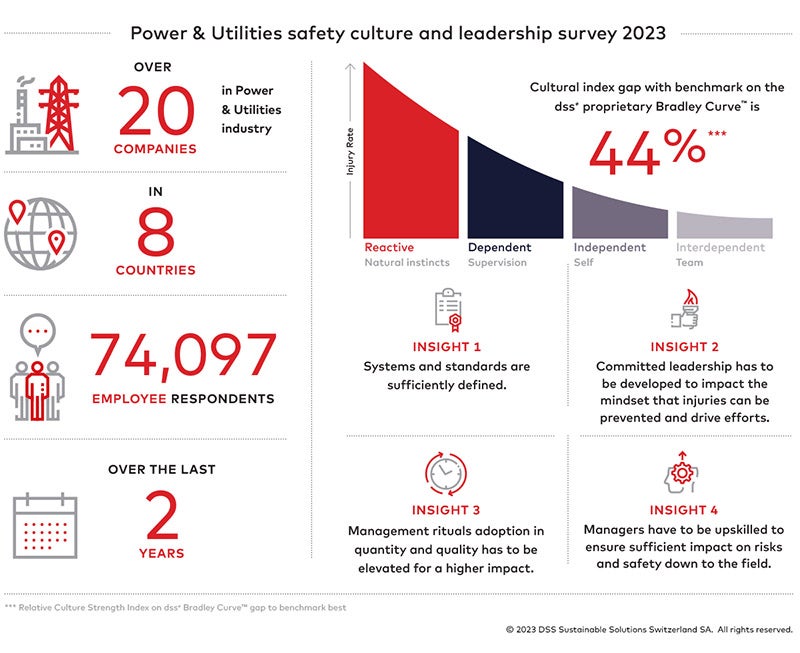
dss+ is a Business Reporter client.
Rapid transformation in the power and utilities sector provides both exciting opportunities and major operational challenges
Rapid transformation in the power and utilities sector is exposing businesses to new risks, including serious injuries and fatalities (SIFs), that unless challenged will undermine trust in their ability to manage risks and be competitive.
But the transformation also reveals major business opportunities – new supply chains, rapid recruitment and an increase in third-party contracted work. Added to this is the transition to new energies and technologies, and different operating models.
Organisational footprints are also changing, with companies building or acquiring new assets while maintaining ageing ones. More workers and contractors are also now working remotely. Consequently, managers struggle to implement operating standards, enforce operating discipline and ensure safe operating procedures. The result is a worrying increase in SIFs.
The pressure to transform at pace means companies do not anticipate and address the evolving reality of construction work and operations. Workplace injuries demonstrate how difficult it is to meet the demands for change while maintaining standards.
So how can SIFs be prevented? And how can businesses be future-proofed?
Risk profile
The key is understanding the risk profile of current and future operations – identifying top risks, prioritising prevention actions and raising awareness of the critical safety barriers and controls required to ensure robust and effective implementation.
The infographic below confirms that managers struggle to develop an understanding of risk profiles, and to elevate awareness and focus on the right level down to operations.
The conventional risk suppression, reduction and mitigation approach is not enough to deal with the evolving nature and magnitude of risks. Managers should develop their ability to recognise risks to focus efforts on the most critical ones. The high pace of transformation, lack of time, complexity and fragmentation of some organisations now requires excellence in focusing the time spent on safety; more specifically, the time spent on the critical risks.
Efficient upskilling or reskilling
As well as enhancing their own ability to understand and anticipate the risk profile of operations, managers and leaders must work to elevate company culture and impact mindsets and behaviours by demonstrating committed leadership.

Skills development for leaders and managers should therefore be accelerated. Upskilling managers now will help them to cope with the future demands of the energy transition and the major transformations required to reach Net Zero goals in Europe.
Managers, particularly capable ones, are already a scarce resource, with most already dealing with multiple business and operations transformation initiatives. Therefore mobilising them on a safety performance improvement journey only works if it’s done efficiently.
It is about providing them with efficient and impactful support in daily life – during their management rituals, improvement initiatives and field interactions, and at any moment they seek to impact the mindsets and behaviours of their teams on the key risks.
Operations management consultant dss+ recommends that in-situ coaching be sat at the core of the safety performance improvement journey. This will ensure efficiency, rapid practical skills elevation and high sustainable impact.
Accelerate the time to impact
Companies must address SIFs quickly. Yet identifying and implementing actions while navigating organisational complexity is difficult.
A strong push from above can mobilise and stimulate the whole organisation, but a well-designed and implemented programme, one that is bespoke and structured, is also required.
dss+ helps businesses to focus on specific areas of the organisation – a business process, a technology, a team, and so on – to streamline and accelerate the transformation process.
A recent dss+ sample of 12 large safety transformation programmes reaching more than 25,000 managers showed that a 24-week upskilling or reskilling programme enables companies to reverse the trend of declining safety performance and reach the necessary autonomy for sustainable results.
The approach starts by rapidly diagnosing the situation, confirming the areas and risks to focus on and the key actions required. It then engages leadership with implementation decisions and visible actions, before supporting deployment.
Four key actions to initiate your transformation
Surface the burning platform
It’s important to look not just at the obvious events but also at the low-intensity signals: increased number of near misses, production losses, poor management reaction to unsafe acts, and so on. Additionally, actual KPI trends reveal little about the future risks organisations will have to cope with. Managers should develop the ability to anticipate future risk profiles.
Articulate the business case in the boardroom
Sizing the outcomes and developing the business narrative that supports the opportunity to launch a safety transformation programme is a prerequisite for alignment and further acceleration. In that regard, many companies look at potential savings from incident reduction but underestimate the strategic benefits they can gain on operational excellence, predictability, attractiveness and competitiveness.
Evaluate current initiatives and capabilities
Organisations should review current improvement initiatives and determine whether these will deliver expected results. They must also look at internal HSE capabilities and consider organisational adjustments for closeness of support and level of support. If the speed, depth of change and nature of support required exceeds capabilities, they will require external support.
Identify success factors
These include a strong sense of purpose and forward momentum, as well as the adaptation of the deployment strategy and support for each perimeter specificity. For such initiatives targeting managers, critical mass considerations are important. First improvement signals are visible when a critical mass of 25 per cent of managers are upskilled or reskilled; for sustained impact, this critical mass must be further increased and maintained above 75 per cent.
Recognising and addressing the challenges in safety management is paramount, and it brings strategic benefits. dss+ recognises the challenges that power and utilities companies face in adapting to changing demands while addressing increasing SIFs. We offer clients our expertise in management upskilling and reskilling programmes, aiming to equip them with the tools not only to manage the evolving business landscape but also to affect meaningful business transformation.
For more information, visit consultdss.com.

Mathieu Leduc, Europe Regional Director: Power & Utilities



